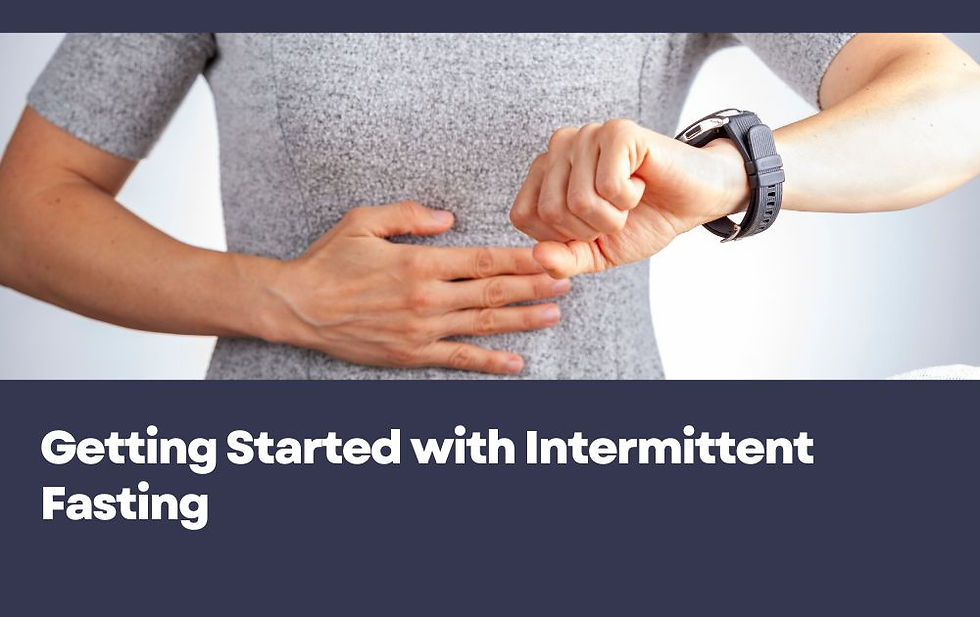Transform Your Wellness Routine with Intermittent Fasting
- Jul 22
- 4 min read
In a world where health trends come and go, intermittent fasting has emerged as a sustainable approach to wellness. It’s not just about what you eat but when you eat. This strategy has gained traction due to its ease of use and the substantial health benefits that come with it. Many people have found that intermittent fasting helps them regain control over their eating habits while improving their overall health. Let’s explore how this can transform your wellness routine.
Intermittent Fasting Benefits
Intermittent fasting involves cycling between periods of eating and fasting. This method is flexible and doesn't prescribe what to eat but instead focuses on when to eat. This can lead to numerous health benefits, ranging from weight loss to improved metabolic health.
Research shows that intermittent fasting can aid in weight management. According to a study published in the Journal of Translational Medicine, participants who followed an intermittent fasting regimen lost more fat than those who didn't, despite similar caloric intake. This could be due to the natural reduction in eating periods, which often results in fewer calories consumed overall.

Another compelling benefit is its effect on metabolic processes. Intermittent fasting may enhance insulin sensitivity. Improved insulin sensitivity can lead to lower blood sugar levels, reducing the risk of Type 2 diabetes. A study published in the journal Cell Metabolism found that participants who practiced intermittent fasting showed significant improvements in insulin sensitivity compared to those who followed traditional dietary plans.
Moreover, fasting has been linked to improved brain function. Research suggests that alternate-day fasting could improve brain health and may even lower the risk of neurodegenerative diseases such as Alzheimer’s. This occurs because fasting encourages the production of brain-derived neurotrophic factor (BDNF), a protein that supports neuron growth and function.
Getting Started with Intermittent Fasting
The beauty of intermittent fasting is that it can fit into various lifestyles. The common methods include the 16/8 method, the 5:2 diet, and alternate-day fasting.
16/8 Method: This method limits eating to an eight-hour window, allowing for a 16-hour fasting period each day. For example, you could eat between noon and 8 PM.
5:2 Diet: With this approach, you eat normally for five days of the week but limit calorie intake to 500-600 on the remaining two days.
Alternate-Day Fasting: This more extreme method involves alternating between fasting days and normal eating days.
Choose a method that suits your lifestyle and try it out. It may take a few weeks to adjust as your body adapts to the new eating schedule.

Is it better to fast for 12 or 16 hours?
When it comes to deciding between a 12-hour or a 16-hour fast, research points toward the benefits of a longer fasting window. While both can be beneficial, fasting for 16 hours offers a more extended period for your body to enter a state of ketosis, where it starts burning fat for energy.
During a 12-hour fast, your body has less time to benefit from these metabolic changes. However, for beginners, a 12-hour fast can still be effective—it’s about finding what works for you.
Start small. If you are new to fasting, commence with a 12-hour fast. You can gradually work your way up to 16 hours as your body adjusts. Listen to your body and find a fasting window that feels comfortable for you.
Overcoming Challenges
Starting any new routine can pose challenges, and intermittent fasting is no exception. Some might experience hunger pangs or irritability at first. Staying hydrated is crucial during fasting hours. Drinking water or herbal teas can help keep you full and focused.
To make the transition easier, consider planning meals in advance. Eating nutrient-dense foods during your eating window can minimize hunger and ensure your body receives essential nutrients. Focus on whole foods like lean proteins, whole grains, fruits, and vegetables.
Incorporate mindful eating. Paying attention to what you consume can help you savor your meals and recognize hunger cues. Avoid the temptation to binge during your eating window. Instead, aim for balanced meals to keep energy levels stable.

The Long-Term Impact on Your Health
Integrating intermittent fasting into your wellness routine can yield long-lasting health benefits beyond weight management. Studies have shown that intermittent fasting can promote longevity. Research in mice has indicated that alternate-day fasting can improve lifespan and reduce obesity-related diseases.
It's essential to note that intermittent fasting is not a one-size-fits-all solution. Individual experiences may vary, and it’s advisable to consult with a healthcare professional before undertaking significant dietary changes, especially if you have pre-existing health conditions.
Furthermore, the emotional and mental aspects of fasting should not be overlooked. Many participants report improved mental clarity and focus during fasting periods. This can lead to heightened productivity and better overall cognitive function.
As you embrace this approach, it’s vital to maintain a holistic view of wellness. Combine intermittent fasting with regular exercise, sufficient sleep, and stress management techniques to achieve optimal health.
In summary, intermittent fasting presents a transformative opportunity to enhance your health and wellness routine. With its array of benefits, including weight management, improved metabolic health, and potential longevity, exploring this method could be a step toward a healthier life.
Ready to jump into fasting? The journey begins with understanding your body’s needs and aligning them with your goals. Start today and discover how intermittent fasting can transform your wellness routine.








Comments